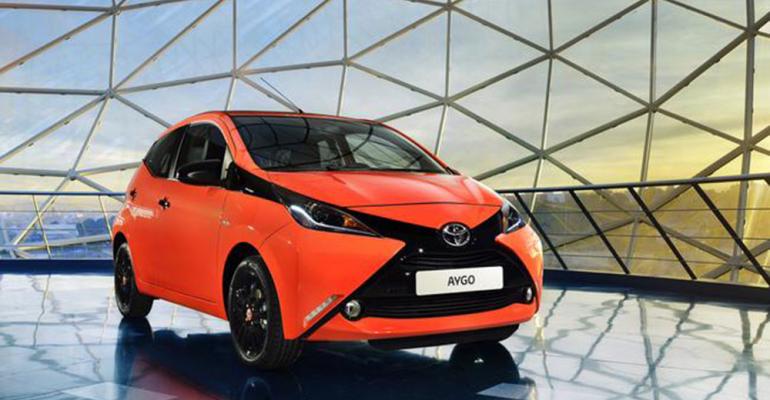Toyota, Honda and Nissan debuts at the 2014 Geneva auto show each are an effort to woo younger and/or performance-focused European car buyers.
Toyota unwraps the next-generation Aygo at its show stand. The A-segment car keeps with the directive from Toyota President Akio Toyoda to build more fun-to-drive vehicles, from a brand that has been synonymous with blander efforts.
The new Aygo also is an effort to inject some personality into traditionally basic small cars.
“My main driver was to create a car that people would fall in love with,” Aygo Chief Engineer David Terai says. “In a crowded marketplace, it is better to have a design that half the people absolutely love, rather than one that nobody objects to.”
Toyota touts the extreme personalization available in the Aygo, giving buyers the option to change about 10 parts to “alternative colors or executions” via exterior and interior “packs.”
In the interior, the vents and gear-lever surround can be changed, for instance.
The Aygo is roomier than its predecessor and comes with youth-centric equipment, Toyota says, such as a 7-in. (18-cm) touchscreen controlling various functions and MirrorLink smartphone connectivity.
The Aygo’s 1.0L gasoline 3-cyl. sees improved performance and fuel efficiency thanks to upping the compression ratio from 11.0:1 to 11.5:1 and cutting friction losses with a new timing chain.
The Aygo makes 68 hp and 70 lb.-ft. (95 Nm) of torque, and fuel economy ranges from 56 mpg (4.2 L/100 km) in the grade with an automated manual transmission to nearly 60 mpg (3.9 L/100 km) in Eco grade.
The design of the car was inspired by Japanese youth culture and has lines mimicking the expansion of a soft object breaking through a hard shell.
Exterior parts, such as the front grille and rear-bumper insert, also can be changed via a pack.
At Honda, the next generation of the automaker’s popular Civic Type R hatchback is teased with a concept.
“The styling of the car is heavily linked to performance,” Honda says. “Many of the styling features offer real performance benefits, in addition to aesthetics, as confirmed by feedback from prototype testing at the famous Nurburgring Nordschleife in Germany.”
The track time resulted in a stand-out rear spoiler designed for added downforce, larger upper and lower grilles, and hood outlets for improved engine cooling.
The Type R, debuting next year in Europe, will use Honda’s new VTEC turbocharged Earth Dreams engines. A 2.0L, direct-injected-and-turbocharged gasoline 4-cyl. is expected to deliver 276 hp and will be compliant with Euro 6 emissions standards.
Also in Geneva, Honda debuts the NSX supercar’s powertrain layout, a longitudinal, V-6 DI twin-turbo paired with Honda’s 3-motor Sport Hybrid Super-Handing All-Wheel-Drive system, and announces its new hydrogen fuel-cell vehicle will be sold in Europe in early 2016.
Nissan takes the covers off its next-gen Juke small CUV, a model that has been a big success for the brand in Europe, racking up 135,000 sales in 2013, with up to 85% sold to first-time Nissan buyers.
“The changes we have made to new Juke will extend (its) appeal even further to cement Nissan's position as the leading brand in the crossover market,” says Guillaume Cartier, senior vice president-sales and marketing for Nissan in Europe.
The new Juke has a downsized 1.2L DI turbo 4-cyl. gasoline engine, developed by the Renault-Nissan Alliance. It replaces the current base engine, a 115-hp, 1.6L naturally aspirated 4-cyl.
While horsepower is reduced slightly with the new mill, to 113 hp, torque rises to 140 lb.-ft. (190 Nm).
Stop/start is standard and the 1.2L is less polluting than the 1.6L, emitting 126 g/km of carbon dioxide, Nissan says.
The Juke’s other gasoline engine, a turbo DI 1.6L, is tweaked for more torque below 2,000 rpm, adds cooled exhaust gas recirculation and has a higher combustion ratio of 10.5:1 from 9.5:1.
The Juke’s lone diesel, a 108-hp, 1.5L goes unchanged.
The CUV now has more room for cargo, with the luggage area expanded 40% in 2-wheel-drive models.
The Juke’s exterior retains its progressive look, but a few changes have been made, including a new Nissan-brand signature on the grille and “more robust trim” beneath the bumper.
Door mirrors get LED side-turn strip repeaters and optional cameras for Nissan’s Around View Monitor system.
The rear-bumper shape is described as “more aggressive” and matches new boomerang taillamps.
The CUV now comes in 10 colors, including three new shades: a yellow or blue metallic and a solid red.
Personalization is possible with color inserts for wheels and packs of contrasting colors for mirror caps, side sills, the roof spoiler and door handles.
Nissan leaves the Juke’s motorcycle-inspired center stack largely untouched, but interior packs are available to change the center console and door trims to red, white, black or bright yellow.
NissanConnect smartphone connectivity is added to the Juke, and there are various Internet-radio and social-media apps available.
Nissan’s latest-generation satellite navigation system integrated with Google provides weather, hotel and restaurant data, among other features.
Nissan also uses its Geneva stand to unveil the production version of its electric NV200 van.
The e-NV200 uses a powertrain based on the Leaf’s to achieve 106 all-electric miles (170 km per the New European Driving Cycle) of range.
Sales in Europe begin in May, and two variants will be available: a cargo van or a 5-seat people carrier in two grades.





